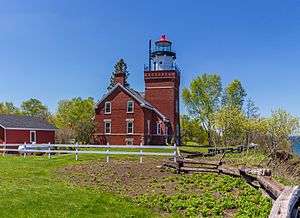Big Bay Point Light facts for kids
 |
|
|
|
|
| Location | Big Bay, Michigan |
|---|---|
| Coordinates | 46°50′25″N 87°40′55″W / 46.84028°N 87.68194°W |
| Year first constructed | 1896 |
| Year first lit | 1896 |
| Automated | 1941 |
| Deactivated | 1961 (Now Private Aid to Navigation) |
| Construction | Brick and reinforced concrete |
| Tower shape | Octagonal lantern atop square tower which sits on attached duplex bed and breakfast |
| Markings / pattern | red brick with white lantern |
| Height | 64 feet (20 m) |
| Focal height | 108 feet (33 m) |
| Original lens | Third order Fresnel Lens |
| Range | 9.6 nautical miles; 18 kilometres (11 mi) |
| ARLHS number | USA-053 |
| USCG number | 7-14705 |
The Big Bay Point Light is a cool lighthouse that stands tall on a rocky cliff near Big Bay, Michigan. It's about 24 miles (39 km) northwest of Marquette in the Upper Peninsula of Michigan. What makes it extra special? It's the only working lighthouse in the United States that also operates as a bed and breakfast! Some people even say it's haunted.
Contents
History of the Big Bay Point Light
The idea for a lighthouse at Big Bay Point came up in 1882. The area was dark between two other lighthouses, Granite Island and Huron Islands. This gap was dangerous for ships. Many vessels had crashed on Big Bay Point before the lighthouse was built.
Building the Light Station
Workers built a brick fog signal building, about 20 by 15 feet (6.1 by 4.6 m). It had two large steam train whistles. These whistles would blow loudly to warn ships in foggy weather. Later, in 1928, modern air horns replaced the steam whistles.
The station also had small brick privies (outhouses). There was also a brick building to store oil for the light's lens.
On October 20, 1896, the lighthouse officially began operating. It used a special 3rd-order Fresnel lens. This lens was very powerful and created a bright white flash every twenty seconds. Fresnel lenses are known for their amazing design. They use many concentric glass prisms to focus light. This makes the light shine very far.
The lighthouse tower had an office on its lower level. Each side of the building had six rooms. This included a kitchen, parlor, and dining room downstairs. Upstairs, there were three bedrooms. Each side also had a basement to collect rainwater from the roof. This water was pumped to the kitchen sink.
From Lighthouse to Home
The lighthouse was no longer needed by the government in 1961. It was sold to a private owner, Jon Pick, for $40,000. For six years, the lighthouse was empty and fell into disrepair. The roof was missing, windows were broken, and plaster was falling off the walls.
Jon Pick spent 17 years fixing up the lighthouse. He added modern plumbing, electricity, and heating. Many rooms were re-plastered. He turned the two separate keeper's homes into one large building. He filled it with old furniture and items from his travels.
Becoming a Bed and Breakfast
In 1979, Jon Pick sold the lighthouse to Dan Hitchens. Hitchens added more bathrooms and meeting rooms. He planned to turn the lighthouse into a bed and breakfast.
Five years later, in 1984, Hitchens sold it to a new group of owners. Norman Gotschall and his wife managed the property. They added more bed-and-breakfast features. They also reopened the fog signal building and created hiking trails. The Big Bay Point Light Bed and Breakfast opened its doors in 1986.
In 1992, three people from Chicago bought the lighthouse. They had stayed there as guests and loved it. They are the current owners (as of 2015).
The lighthouse was built in 1896 for $25,000. It became automated (meaning it ran itself) in 1944. It has been a bed and breakfast since 1986. Visitors can take tours of the lighthouse and the fog horn building.
Life at the Lighthouse
The keeper's house has 18 rooms in a large, two-story brick building. The attached tower is 105 feet (32 m) tall above Lake Superior. Originally, this building housed the main Lighthouse keeper and his family. It also housed an assistant keeper and his family. Later, a smaller building was added for a second assistant keeper.
When the lighthouse was built, the only way to get there was by boat. The lighthouse keepers and their families were very isolated. The keepers' wives had to do all the housework and cooking. They also had to teach their children at home.
Other buildings on the property included two cisterns (for water), an oil house, a garage, and two brick outhouses. There was also a dock and a well house. The brick fog signal building once held the original Fresnel lens. However, that lens is now on loan to the Marquette Maritime Museum in Marquette.
The light tower has fancy brickwork near the top, like a fortress. It supports an octagonal lantern and an iron watch room. The light was automated in 1941. The station was sold in 1961. This happened after a new light was put on a steel tower nearby.
Current Status of the Lighthouse
The Big Bay Point Light Station was added to the National Register of Historic Places on November 12, 1988. It is also listed on Michigan's state historic list.



